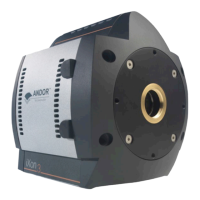Page 24
Features & Functionality
Figure 17 shows how the EM gain varies with temperature, this dependence arising primarily from photon scattering of
electrons when they are accelerating in the EM electric eld. The scattering causes a loss of energy, which increases with
temperature. To make up this loss and maintain EM gain, a larger EM electric eld must be used at higher temperatures.
As can be seen from Figure 18, EM gains well in excess of x1000 can be achieved at low temperatures. However it is
not recommended that gains above x1000 be used because such high gains can cause signicant ageing of the gain
register (see EM Gain Ageing on page 32).
3.1.6 - RealGainTM : Real and Linear gain
Through a detailed analysis of the complex EM voltage dependence Andor have successfully converted the relationship
between EM gain and the EM clock voltage setting into a linear one. Importantly, the actual EM gain can be selected
directly from a linear scale displayed in software. No more guesswork with arbitrary gain units on a non-linear scale - the
gain you ask for is the gain you get.
Select the best gain to overcome noise and maximize dynamic range. Also, although EM gain is temperature dependent,
Andor’slinearandrealgaincalibrationextendstoanyEMCCDcoolingtemperature.Selectingx300EMgain@-50°C,
orat-100°Cgivesthesamex300actualgain!Thisdeliversanewbenchmarkofsimplicityandeaseofoperationtothe
user and sets a new precedent in what should be expected from EMCCD technology.
Figure 18: RealGain™
calibration in the
iXon3 – the same
linear relationship
holds across all
cooling temperatures
Figure 17:
EM gain vs
sensor cooling
temperature

